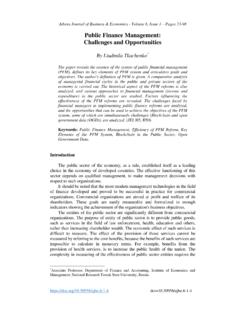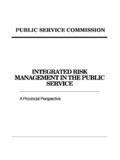Transcription of Community-Clinical Linkages for the Prevention and Control ...
1 Community-Clinical Linkages for the Prevention and Control of Chronic DiseasesA Practitioner s GuideThis guide was developed by the Division for Heart Disease and Stroke Prevention (DHDSP) of the Centers for Disease Control and Prevention (CDC), with support from CDC s Division of Community Health (DCH) and Division of Diabetes Translation (DDT ). The project leads and the authors wish to thank state reviewers Robin Edelman (Vermont) and Miriam Patanian (National Association of Chronic Disease Directors) for their CitationCenters for Disease Control and Prevention . Community-Clinical Linkages for the Prevention and Control of Chronic Diseases: A Practitioner s Guide. Atlanta, GA: Centers for Disease Control and Prevention , Department of Health and Human Services; addresses of nonfederal organizations are provided solely as a service to our readers.
2 Provision of an address does not constitute an endorsement by CDC or the federal government, and none should be inferred. CDC is not responsible for the content of other organizations web Linkages for the Prevention and Control of Chronic DiseasesA Practitioner s Department of Health and Human ServicesCenters for Disease Control and PreventionNational Center for Chronic Disease Prevention and Health PromotionDivision for Heart Disease and Stroke PreventionApplied Research and Evaluation BranchContentsAbout This Guide ..1 Introduction ..2 Strategies ..4 Basic Terms ..5 Learn About Community and Clinical Sectors ..9 Identify and Engage Key Stakeholders from Community and Clinical Sectors ..12 Negotiate and Agree on Goals and Objectives of the Linkage ..16 Know Which Operational Structure to Implement.
3 19 Aim to Coordinate and Manage the Linkage ..21 Grow the Linkage with Sustainability in Mind ..23 Evaluate the Linkage ..25 References ..31 Resource 2. Criteria for Identifying Organizations that Can Support a Community-Clinical Linkage ..34 About This GuideCommunity-clinical Linkages are defined as connections between community and clinical sectors to improve population health. This document guides public health practitioners on key strategies to implement Community-Clinical Linkages that focus on adults 18 years or guide, Community-Clinical Linkages for the Prevention and Control of Chronic Diseases: A Practitioner s Guide, is based on a review of peer-reviewed journal articles, gray literature publications, publicly available program information, and conversations with Centers for Disease Control and Prevention (CDC) grantees and others who have participated in Community-Clinical guide offers the following information on each strategy: rationale, key considerations, and potential action steps.
4 YRationaleExplains why the particular evidence-based strategy is important to support a Community-Clinical linkage. yKey ConsiderationsIncludes information that may be important for public health practitioners to have when implementing a particular strategy. yPotential Action StepsIdentifies potential steps that public health practitioners can take to implement a particular addition, this guide presents resources for public health practitioners to use when implementing the strategy and examples of Community-Clinical Linkages . public health practitioners can use these examples as models for Community-Clinical Linkages in their health leaders have prioritized Community-Clinical Linkages as an effective approach to prevent and Control chronic diseases. For example, CDC s National Center for Chronic Disease Prevention and Health Promotion (NCCDPHP) recommends coordinating chronic disease Prevention efforts in four key areas or domains, one of which is community programs linked to clinical services, or what this guide calls Community-Clinical Linkages .
5 The other three domains are epidemiology and surveillance, environmental approaches, and health care system clinical and community sectors work synergistically, they can improve care and support patients better than either of these sectors could do alone. NCCDPHP promotes Community-Clinical Linkages as helping to ensure that people with or at high risk of chronic diseases have access to the resources they need to prevent, delay, or manage chronic conditions once they occur. Similarly, the Institute of Medicine upholds that enhanced collaboration among the public health, health care, and community non-health care sectors could produce better Prevention and treatment outcomes for people living with chronic diseases. As Community-Clinical Linkages have gained prominence as an effective approach in the Prevention and Control of chronic diseases, science and translation of research for this approach has increased.
6 Programs that have used this approach have documented improvements in clinical health outcomes and behavioral changes. For example:Improved clinical health outcomes have been documented in the Control of: yCoronary heart disease. yBlood pressure. yCholesterol. yPrediabetes. yDiabetes. behavioral changes have been documented in: yNutrition. yPhysical activity. yDiabetes self-management behaviors. ySmoking cessation levels. yMedication Linkages are connections between community and clinical sectors to improve population addition, Community-Clinical frameworks and tools have been developed to prevent and Control type 2 diabetes and obesity and to measure Community-Clinical relationships. Despite increased focus on Community-Clinical Linkages in the literature, particularly in relation to community health workers, there is little information about how to implement this approach.
7 This guide serves to fill that gap and presents strategies that involve practitioners from the public health sector who are leading efforts to link community and clinical sectors (see Figure 1).Figure 1. public Health sector Linking Community and Clinical SectorsCommunity SectorComposed of organizations that provide services, programs, or resources to community members in non-health care Health SectorComposed of public health organizations that can lead efforts to build and improve Linkages between community and clinical sector Composed of organizations that provide services, programs, or resources directly related to medical diagnoses or treatment of community members by health care workers in health care and individuals working in public health can lead efforts to link the sectors in the following ways: yEstablishing and maintaining strategic partnerships within community and clinical sectors.
8 YFacilitating the connection between community and clinical sectors. yContributing infrastructure and capacity support ( , content area expertise, such as evaluation, funding, and staff ). yProviding a population-based perspective on local issues related to chronic disease Prevention and Control . yInforming practitioners and community representatives about the latest evidence-based approaches. yLinking and aligning local and state efforts to national initiatives, such as Million Hearts .StrategiesThe following seven strategies have been shown to be effective for implementing Community-Clinical Linkages :Learn about community and clinical and engage key stakeholders from community and clinical and agree on goals and objectives of the which operational structure to to coordinate and manage the the linkage with sustainability in the TermsAs indicated previously, Community-Clinical Linkages are connections between community and clinical sectors to improve population health.
9 The terms connections, community sectors, and clinical sectors have been used in various ways. Sometimes, community health centers and other Federally Qualified Health Centers are regarded as community-based organizations. Other times, they are regarded as belonging in the clinical sector . Likewise, some people view state and local health departments as being part of the clinical sector rather than as part of the public health sector . Because of these types of variations, it is important to define key terms as they are used in this SectorThe community sector is composed of organizations that provide services, programs, or resources to community members in non-health care settings. Examples include: yCommunity pharmacies (as opposed to a pharmacy in a health care setting, such as a hospital).
10 YEmployers. yPrisons and jails. yFaith-based organizations. yBarbershops. yCommunity centers ( , senior centers). yVolunteer organizations ( , American Heart Association). yNonprofit organizations ( , YMCAs).Clinical SectorThe clinical sector is composed of organizations that provide services, programs, or resources directly related to medical diagnoses or treatment of community members by health care workers ( , physicians, nurses, nursing assistants, physical therapists, emergency medical service personnel, dentists, pharmacists, laboratory personnel) in health care settings. Examples of these include: yHospitals. yFederally Qualified Health Centers ( , community health centers, public housing primary care programs, migrant health centers). yRural clinics. yGroup practices.


















